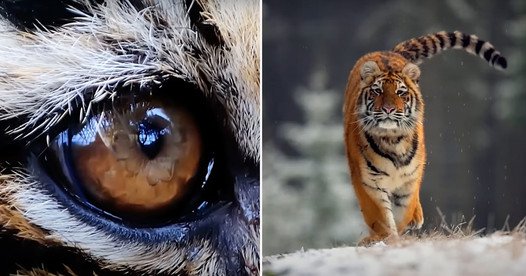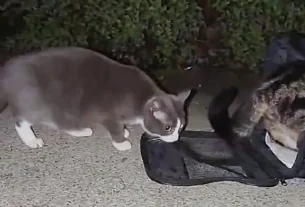Can big cats like tigers feel strong emotions and take deliberate and premeditated actions when harmed? They can, as told in “The Tiger, a True Story of Vengeance and Survival” by John Vaillant.
The real-life story took place in a small village in Primorye, Russia, in December 1997. Today, the area is the last stronghold for the extremely rare Amur tigers and leopards, as well as many other now-rare animals.

The Encounter in the Snow
One morning, while out hunting with his dogs, a poacher named Vladimir Markov came across the large tracks of an Amur tiger in the snow. Following them, he saw the tiger feeding on a wild boar and shot, wounding the tiger. After the tiger retreated, Markov stole the tiger’s kill. He then tried to track down the tiger but couldn’t find it in the deep snow. Realizing the tiger hadn’t died, he knew he was in trouble.

The Tiger’s Retaliation
At 10 feet long from nose to tail, the 500-pound Amur tiger, commonly called the Siberian tiger, can leap 25 feet straight up into the air. For comparison, it would be like jumping over a basketball hoop effortlessly.
Here’s Cat Man Chris showing why one should never turn their back on big cats:
As formidable as tigers are, in the subtropical forests of the Primorye, they rarely attack humans, much less eat them. Native peoples have coexisted with them for centuries, worshipping and even sharing their food with them. They had an understanding, a sort of long-standing truce. But not so for modern settlers who drove the tigers and leopards to the brink of extinction thoughtlessly. Unfortunately, poaching became a way to bring in money in the impoverished area.
Although most times, big cats flee the scent of a human, this time, the tiger fought back… for days. A tiger wouldn’t forget the human who injured him, as the local people knew.

The Poacher’s Grim Fate
The Amur tiger tracked the man who hurt him to his small hunting lodge, almost 7 miles (11 kilometers) away. Enraged by the poacher’s attack, the tiger destroyed everything at the location with Markov’s scent on it, shredding it all. Accounts say the tiger found the boar meat stolen by the poacher.
Unable to find Markov, it lay in wait for him for as long as 48 hours. It was a premeditated plan.
“This wasn’t an impulsive response,” Vaillant wrote. “The tiger was able to hold this idea over a period of time.”

When Markov eventually returned to the lodge, he stood little chance. The tiger annihilated him. Investigators found little left of his body. We’ll spare you the grisly details. But the evidence pointed to the tiger Markov had wounded days earlier.

From there, Yuri Trush, who had been working to save the tigers from poachers, had to track down the tiger to stop it. But not before another young trapper, Andrei Pochepnya, was also devoured. Other poachers had fled as they heard about Markov’s fate.

A Tiger Defending its Livelihood
People are often reluctant to consider what animals are thinking for fear of anthropomorphism. But the Amur tiger had been persecuted to the edge of extinction by intruders in its ancient territory. And the animals remembered.
Maybe it’s similar to the stories of Orcas recently turning over boats. It’s likely the whales have a long memory about what humans have done to their environment.
“It was men who were responsible for the aggression of this animal,” said Trush, “and the incident with Markov was a sort of quintessence of all these cases.”

‘Don’t Steal from Tigers’
In a History Channel episode about the story, a biologist and zoologist gave their views on the tiger’s actions. Was the tiger responding to a perceived threat to livelihood? Or was it much more personal?
“Big predators will kill smaller predators with which they compete,” says biologist Daniel Blumenstein. “And, there’s a long history of human competition with predators. So, it’s possible the tiger was viewing this as competition and ‘I want to get rid of a competitor because this is a threat to my livelihood.’ So, don’t steal food from tigers is the lesson that stands out from Markov’s story.”
One could also see this as a story of not stealing a tiger’s home, as people have done to wildlife across the world. These beautiful creatures deserve wild places to remain free from poachers and other intruders. If we don’t leave ample room for wildlife, then we’re ultimately harming ourselves too.
Alternatively, a zoologist thought the cat’s actions pointed to strong emotions and vengeance.
“You can’t look at this story of Vladimir and not think this is a story of vengeance,” says Zoologist Corbin Maxey. “The tiger stalked Vladimir’s cabin. It waited for Vladimir to return home for the attack. Everything here points to premeditation…these animals can feel these emotions.”

Animals Feel Like Us
Blumenstein agreed: “All animals have neurochemical responses which are remarkably similar across all sorts of species. They feel. Emotions are feeling things that influence behavior, exactly the same as we do.”
In that light, the Amur tiger was retaliating to seek justice for what the poacher had done, and even for what other human intruders had done over its lifetime. The story shows that animals feel strongly and won’t forget what we’ve done.
In recent years, nature preserves in the Primorye have given the Amur tigers and leopards the room they need to roam freely. Nevertheless, their future remains on the edge. Will people remember how much these animals enrich the world before it’s too late?



